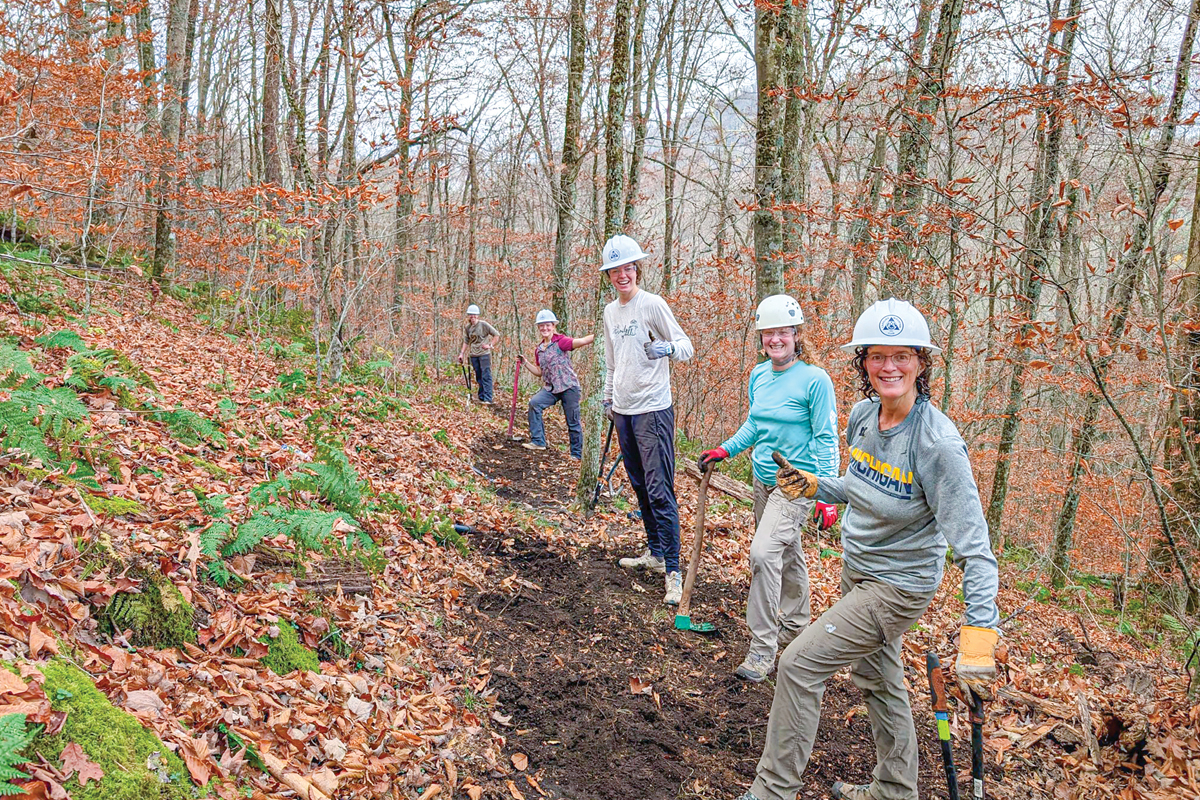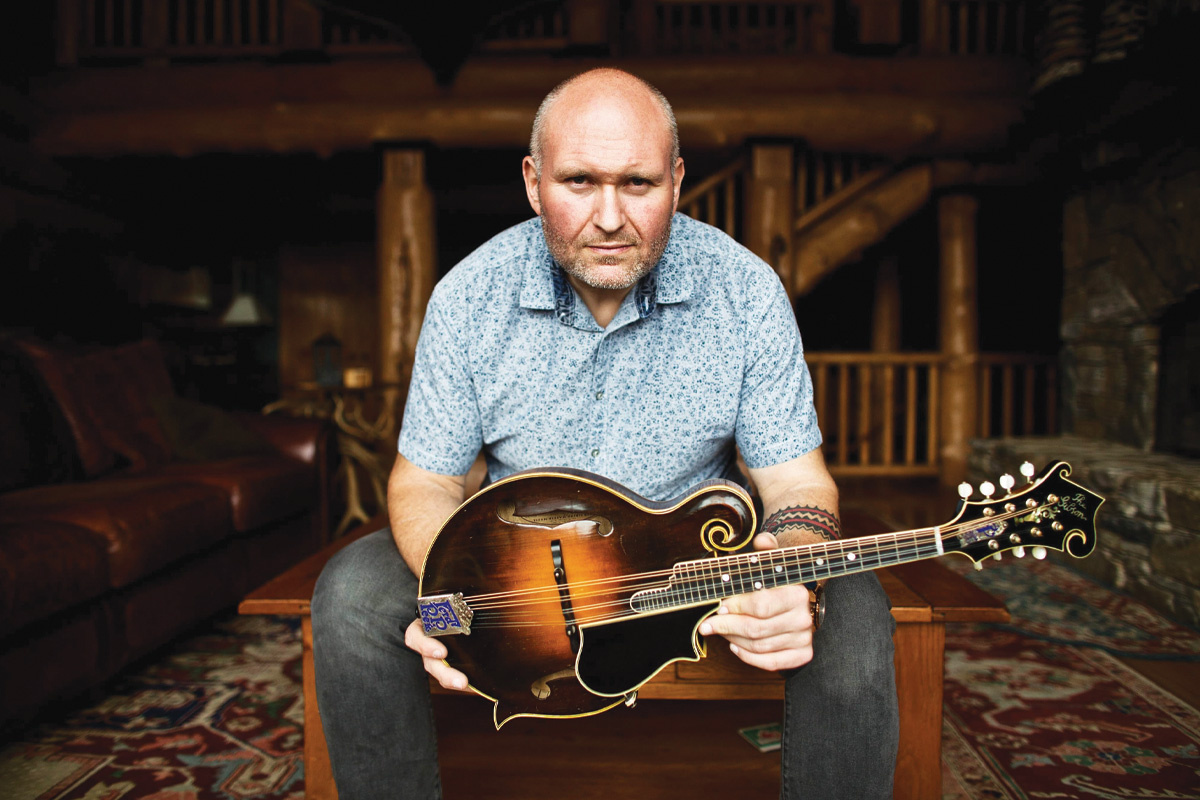WNC cries foul over air pollution payments going down East
 Western North Carolina for now has dodged concerns that it was getting short shrift in a legal settlement intended to compensate the region for air pollution blowing in from dirty coal plants operated by the Tennessee Valley Authority in neighboring states.
Western North Carolina for now has dodged concerns that it was getting short shrift in a legal settlement intended to compensate the region for air pollution blowing in from dirty coal plants operated by the Tennessee Valley Authority in neighboring states.
Mapping Mountain Treasures: Wilderness on the line
A sweeping review of the Pisgah and Nantahala national forests will get under way in a matter of months, a behemoth, multi-year process that will layout a new blueprint for how the forests are managed for the first time in 20 years.
Environmentalists have been prepping for the forest plan for more than five years already. After all, the fate of 1.1 million acres of public land in the mountains hinges on the vision mapped out in the forest plan.
The changing face of WNC’s national forests
 A million acres of national forests sounds like a lot, and indeed it is. But consider the 8.6 million people who visit the Pisgah and Nantahala national forests every year and those vast green swaths that checker any map of Western North Carolina don’t seem quite so big after all.
A million acres of national forests sounds like a lot, and indeed it is. But consider the 8.6 million people who visit the Pisgah and Nantahala national forests every year and those vast green swaths that checker any map of Western North Carolina don’t seem quite so big after all.
More working poor using food pantries to get by
A clean-cut looking Perry Matthews walked into the food pantry with a smile on his face. He wore a crisp, light blue, long sleeve button-up and tan slacks. His long, dark hair was pulled into a neat ponytail.
It is easy to mistake him for one of the volunteers who prepares meals or packs boxes with food. But Matthews, a 26-year-old employed chef and cooking teacher, is part of a new demographic of working poor in Western North Carolina.
Six months ago after finding himself struggling, Matthews started picking up food boxes from The Community Table in Sylva.
“Times got hard, and it’s everything I can do to get my rent and bills together,” Matthews said. “The electric bill was taking up way too much.”
For Matthews, meals have become a regular community event. His neighbors also frequent the Community Table for donations. Then they pool their food and cook meals that they all share together.
Matthews is not embarrassed to admit he needs help and suggests that others who are scrambling to pay their bills visit the pantry as well.
“You’re hungry, and they’re giving food. It’s plain and simple,” said Matthews, who is one of 17.7 percent of Jackson residents who in 2011 did not have continuous access to food.
Some first-time visitors are ashamed to come to a food pantry because of the stigma associated with it.
“Poverty has such a stigma, and a lot of people have the ‘blame the victim’ mentality,” said Amy Grimes, director of the Community Table. “There are so many factors beyond people’s control.”
So, the Community Table tries to create a happy, community atmosphere, where people can sit and socialize while waiting for food or collecting their food boxes.
“(People) probably think it’s a sad, downtrodden kind of place. No,” Grimes said. “It’s much more dignified.”
The new visitors are not part of the generational poverty cycle but rather lost their job or face unexpected costs.
“We are seeing a lot more situational poverty,” Grimes said. “People have a medical issue come up, and it turns their entire life upside down.”
Although many people enjoy the three-month summer that a job at a school affords, Martina Maldonado would rather work. Every year when Western Carolina University’s campus essentially closes down, Maldonado, a cook at the college, is unemployed and must used food pantries to compensate for the lack of income.
“Any holiday they close, it happens,” said Maldonado, a Spanish woman whose daughter-in-law translates for her.
Their number one customer, however, is still elderly people and mentally challenged individuals, who are usually both on fixed incomes.
The Community Table used to grow busier toward the end of the month when people’s food stamps ran out but now stays busy throughout since the federal government began staggering its food stamp release. Some people get food stamps at the beginning of the month, and others receive them in the middle or end of the month.
“We are just busy all the time now,” Grimes said.
Food shortages persist in the land of plenty
Counties in Western North Carolina have seen dramatic increases in the number of people who need food assistance — either from the government in the form of welfare or from local food pantries.
The number of people on food stamps in Haywood, Macon and Swain counties has increased by more than 40 percent over the past four years.
Foods stamps only go so far, however, so churches, charities and community groups have stepped up to the plate to help feed the hungry.
MANNA food bank serves as the region’s major clearinghouse for food for more than 250 food pantries across Western North Carolina. MANNA collects food and money and distributes it among its member pantries, and as a collective, the pantries have an easier time obtaining government funding.
“It’s a great program,” said Alice Fisher, a board member of another food pantry, The Community Kitchen in Canton. “We couldn’t continue if we didn’t have that support from MANNA.”
The Community Kitchen started in the mid-2000s, and leaders decided to serve dinner since the Open Door Soup Kitchen in Waynesville already offered breakfast and lunch. The pantry also hoped to fill a niche in Canton since Waynesville can be a far daily trek for people without a car or even those on a tight budget, said Beverly Brock, director of The Community Kitchen.
“Waynesville has a soup kitchen, and it’s a good one, but it’s quite a bit of gas to get a meal,” Brock said.
The Community Kitchen sees pretty much every demographic flow in and out of its home on Pisgah Drive.
“It’s the whole gamut — we’ve got elderly, we’ve got disabled, we’ve got multiple generations in one household,” Brock said, adding that they also see grandparents trying to raise their grandchildren on fixed incomes.
And, the number of people they see each week depends on what is happening in an individual’s life.
“It flows with how their bills go this week. Every hiccup can make a big impact,” Brock said. “What we do is just help sustain them.”
The pantry typically goes through 5,000 pounds of food each month, which is about one-third more business than The Community Kitchen did in year’s past.
MANNA as a whole distributed almost 10 million pounds of food last year and still does not meet demand, said Alissa Hixson, a spokeswoman for MANNA food bank.
“As soon as the economy went under, everything changed,” said Amy Grimes, director of the Community Table in Sylva.
The Community Table, which typically made 25 to 40 meals each weekday, now makes 80 to 100. The pantry is closed Saturday and Sundays.
“The need is going up like crazy,” Grimes said. “We are seeing new people every week.”
Pantries are seeing more families come for food, though some college-educated individuals are also visiting the food pantries.
Feeding children
At least 30 percent of the children in Western North Carolina don’t have adequate access to food, according to MANNA food bank. The MANNA backpack program helps to ease that burden by delivering 5-pound bags of food to schools on Fridays and sending them home with children in needy families.
“Those families are struggling over the weekend because the kids do not have a free meal at school,” said Emily Paris, program services coordinator at MANNA.
It serves 3,800 children a week during the school year. But, it’s not nearly enough to meet the needs of all the hungry kids.
Although MANNA does its own fundraising for the program, the Waynesville Rotary Club has decided to make the backpack program its pet project year-round, collecting donations that will go to children in Haywood County in hopes of expanding the program. The Rotary club is accepting checks, but people can also donate by tacking a nominal amount onto their bill when eating at Waynesville restaurants.
As of last week, the club had raised more than $20,000 — all of which will stay in Haywood County, emphasized Brandon Anderson, president of the Waynesville Rotary Club.
“We are excited,” Anderson said. “I am pretty confident that it is going to explode from there.”
Food insecurity rates
Haywood: 16 percent
Macon: 16.9 percent
Jackson: 17.7 percent
Swain: 19.9 percent
Data for 2011, provided by MANNA foodbank
How to help
Giving to MANNA food bank or an individual pantry is simple. Call or stop-by or simply mail in a check or ask to volunteer. Check out www.mannafoodbank.org for specific information about food pantries and soup kitchens in your area.
Other ways to give include:
• The Community Kitchen in Canton is hosting a golf fund-raiser at Lake Junaluska at noon on June 1. Teams are four-person, captain’s choice. Entry fees are $50 per person. 828.593.9319.
• The Open Door Ministries is hosting a Bike Run will begin at 11 a.m. Saturday, June 9. The fund-raiser, hosted by The Carolina Faith Riders, will raise awareness and money for the soup kitchen and thrift store in Waynesville. Registration is from 9-10:45 a.m. There is a $15 per bike entry fee. The route will be from The Open Door, through downtown Waynesville to N.C. 276, across the Blue Ridge Parkway, down Soco, through Maggie. The Bike Run will conclude at Dellwood Baptist Church at 12:30 p.m. with music on the lawn and a lunch. 828.926.3846.
• The last Wednesday of each month from 11 a.m. to 2 p.m., the Community Table hosts a blue plate special fund-raiser. A local restaurant donates lunch, which the pantry offers for a minimum $5 donation. Call ahead for a takeout order, or eat at the pantry. 828.586.6782.
• From June 15-July 15, businesses and organizations in Haywood County will be accepting food that will then be directly distributed to food pantries and soup kitchens throughout the county. The goal is to collect 50,000 pounds of food. Look for red donation barrels outside businesses or call the Chamber of Commerce for a list of locations. Those wishing to make a monetary donation should stop by any Haywood County BB&T. 828.456.3021.
• The Dillsboro River Company will offer free rafts for unguided trips down the Tuckasegee River from 10 a.m. to 3 p.m. June 3 in exchange for10 cans of food per person that will be donated to United Christian Ministries of Jackson County. 866.586.3797.
• Duckett’s Produce in Maggie Valley is collecting food donations. The donations are then taken to the Maggie Valley Methodist Church where those in need are free to pick up food.
GroWNC inspires neighboring counties to think like a region
Haywood is banding together with Transylvania, Buncombe, Henderson and Madison counties under a project titled GroWNC, designed to get the region thinking collectively about ways to develop the economy with a focus on sustainability.
GroWNC is currently holding meetings in all five counties to gain feedback on the goals and gather information about their residents, including one planned in Haywood County this week. Participants are being asked everything from what people love most about Western North Carolina to individual demographics to opinions about the program.
“It is trying to take a long-term vision of the area and see what our common issues are,” said Waynesville’s Assistant Town Manager Alison Melnikova. “It’s basically everything people like about Western North Carolina and preserving it.”
The group will focus on seven core areas: jobs and economic development; housing; natural resources; cultural resources; energy; land use; transportation; and health and wellness.
The consortium is led by an 18-member committee, which is responsible for prioritizing work activities, participating in the selection of consultants and making recommendations to guide the project. Sub-committees have been formed to address the seven specific areas.
Each of the committees has drafted a list of goals that it hopes to work toward that will promote growth and more inter-connectivity between the counties, rather than each county taking its own path.
“GroWNC better conveys our goal of growing together as a region,” said Carrie Runser-Turner, senior planner with Land-of-Sky Regional Council, a multi-county local government planning and development organization. “Really what we are trying to do is look at the choices we make in these areas (and) how they are inter-related.”
Among the goals are creating effective job training programs; exploring alternative energy options; increasing transportation choices; promoting community health resources such as gym class in schools and physical activity programs; building mixed use neighborhoods with a “sense of place;” and encouraging the development of affordable housing, among others.
The meetings being held throughout the project region are informal, allowing people to move from table to table as they wish and skip over areas that they don’t have an particular interest in. Door prizes will also be given away at the meetings.
“The participants get to shape their experience with this meeting,” Melnikova said.
A U.S. Department of Housing and Urban Development grant was awarded to the counties for the project through the Land-of-Sky.
Want to participate?
Haywood Community College will host an informational and feedback meeting from 4-7 p.m. on May 16 in the Charles Beall Auditorium. If you cannot attend the meeting at HCC, check out www.gro-wnc.org for other upcoming meetings and more information about GroWNC.
Voices of the Smokies to go live in oral project
Recordings made some seven decades ago of nearly 60 men and women who lived in what became the Great Smoky Mountains National Park soon will be made publicly available online.
In 1939, a young graduate student by the name of Joseph Sargent Hall traveled through the region’s coves and hollows with an audio recorder powered off his pick-up truck battery, capturing tales of bear hunts, lessons on herbal remedies and authentic mountain tunes. He spent eight months recording the experiences of older residents and the music of young aspiring musicians. Of the 60 interviews, 17 were from Swain County and 16 were from Haywood County.
One of the mountaineers recorded by Hall was the famous Steve Woody of Cataloochee Valley, who was 86 at the time.
“That’s not me; that’s my grandfather,” Steve Woody the younger said with a laugh. “I can remember him.”
Woody owns a tape rendition of the 1939 recording Hall made of his grandfather. It is a story about a bear hunt, Woody said, and there’s also a photograph in the family album of the actual interview taking place, too.
Woody thinks it’s terrific that the old recordings soon will be made easily available.
“It’s a good thing,” he said. “I think people need to know the history of these mountains.”
When the Great Smoky Mountains National Park was created, hundreds of people living in remote Appalachian settlements were forced to move. Hall’s recordings were made just as this was happening, capturing a moment in time and way of life that was coming to an end. Woody’s grandfather was the last person to move out of Cataloochee Valley after the park was created.
The City University of New York will host the non-commercial website where the recordings will be made publicly accessible. A release date hasn’t been set — the project’s members are trying to ensure that living descendants of those recorded are given notice first that the recordings are being made public.
Michael Montgomery, a professor of English and linguistics at the University of South Carolina and a member of the project team, said that the digitized recordings are being made from tape recordings that were, in turn, made in the 1980s from the original recordings.
“They are actually quite clear for recordings made more than 70 years ago,” Montgomery said, adding that the original discs are held in safekeeping in the Library of Congress.
Copies of the recordings are currently available for people to listen to if, that is, they are willing to drive several hours into Tennessee to the Archives of Appalachia at East Tennessee State University.
A chronicler of the people
Using Civilian Conservation Corps camps for home base, Hall ventured throughout the area to record. For this work, Hall used two recorders, one that produced aluminum discs and was operated by cables hooked to a pick-up truck battery and another that made acetate discs and ran on a portable battery pack.
Montgomery said that Hall became close friends with many of the men working in the CCC camps and returned to visit them for many years after the first recordings were made. Hall died in 1992.
Luke Hyde of Bryson City, who had family members who once lived where the park was subsequently created, said he believes it will be helpful to families such as his and for park history buffs in general to have the recordings easily available via a website. In addition to the recordings, searchable texts also will be online.
“I like the general concept,” Hyde said, adding that he is well familiar with the important work done by Hall to record the people of the Smokies.
“He was fascinated by a lot of things, and he listened to people,” Hyde said. “He was one of the chroniclers of the mountain people.”
Montgomery said Hall’s interest in making this set of recordings was to record dialect. That meant he didn’t care so much what people said as long as they said something — so what’s on the recordings are such things as “women talking about herbal remedies and fellows talking about bear hunting,” Montgomery said.
Hall himself wrote about his work that, “the topics of the recordings were anything the informant wished to talk about. Men talked about their farm, their crops, their cattle, and hunting. Women liked to tell recipes or talk about their interest in weaving and quilting and the like.”
Hall also recorded the music of the day. Young musicians played country and swing and other tunes they were hearing on the radio.
“Joseph Hall recorded anything people wanted to play,” Montgomery said.
In 2010, the Great Smoky Mountains Association released “Old Time Smoky Mountain Music,” a CD with 34 of the musical selections recorded by Hall.
Montgomery said that one of Hall’s most admirable traits was his determination to stay in the background and not overshadow the men and women that he was recording.
“He thought that was the best way to counter stereotypes. He wanted mountain people to use their own voices,” Montgomery said. “His approach really was to avoid general statements and to let mountain people speak for themselves.”
Not everyone is certain the release of the recordings is a good idea.
Harley Caldwell, 75, was the last person born in Cataloochee Valley before the park was formed. He’s concerned about the privacy rights of the people who were recorded, about whether they realized that one day their stories and tales would be released publicly.
Caldwell, in fact, is involved in a similar project to Montgomery’s. The Cataloochee Oral History Project teamed with Western Carolina University to record and videotape 33 living descendents from Cataloochee. A DVD is set for release in early 2013.
“It’s a bigger project than I wanted to tackle, but I tackled it anyway,” Caldwell said.
WCU provided the equipment and is editing the interviews and preparing the DVD. Caldwell facilitated the project by rounding up the Cataloochee descendents. Caldwell said, perhaps echoing what Hall also found, that he was most surprised by “the willingness of people to talk about their past.”
One of those men interviewed was age 99, Caldwell said, adding that the man remembered historic events as if they’d occurred yesterday.
“It was the most interesting thing I’ve ever done in my life, and I’ve done a lot of exciting things,” Caldwell said of the oral history project.
One thing Caldwell and his team were careful to do was obtain signed releases from those interviewed — and he worries that, in contrast, Hall’s subjects were never cautioned that one day their voices would be heard again.
Speakers recorded by Joseph S. Hall in 1939:
Haywood County:
• Mack Caldwell, 53, Mount Sterling.
• Mack Hannah, 81, Little Cataloochee.
• Mrs. Mack (Fannie) Hannah, 73, Little Cataloochee.
• Millard Hill, 27, Saunook.
• Mark Mehaffey, Maggie.
• Bill Moore, 21, Saunook.
• Howard Moore, Saunook.
• Manuel Moore, Saunook.
• Mrs. George Palmer, 65, Cataloochee.
• Will Palmer, Cataloochee.
• Mrs. Will Palmer, 69, Cataloochee.
• Herbert Stephenson, 25, Saunook.
• Eugene Sutton, 43, Cataloochee Creek.
• Jake Sutton, 63, Cataloochee.
• Jim Sutton, 70, Cataloochee.
• Steve Woody, 86, Cataloochee.
Swain County:
• Mrs. Bill Brown, Towstring Creek.
• Dan Cable, 73, Cable Branch, Proctor.
• Aden Carver, 91, Bradley Fork, Smokemont.
• Mark Cathey, 54, Deep Creek.
• D. F. Conner, 84, Oconaluftee.
• Bert Crisp, 47, Towstring Creek.
• Zeb Crisp, 64, Hazel Creek.
• Grover Gilley, Bryson City.
• Gladys Hoyle.
• Frank Lambert, 40, Towstring Creek, Smokemont.
• Grady Mathis, 50, Smokemont.
• Al Morris, 67, Kirklands Creek.
• Rebecca Queen, 70, Cherokee.
• Docia Styles, 66, Indian Creek.
• Zilphie Sutton, 70, Chestnut Branch.
• Jake Welch, 79, Ryan Branch, Hazel Creek.
• Fate Wiggins, 79, Deep Creek.
• Mary Wiggins, Deep Creek.
WCU’s Hunter Library releases online oral history collection
A series of oral interviews with the people of Western North Carolina are now available online through Western Carolina University’s Hunter Library.
“Stories of Mountain Folk” is the first all-sound collection released by Hunter Library. The collection’s interviews cover traditions, events and life stories of regional individuals including gardeners, herbalists, farmers, musicians, artists and writers. The archive is searchable by name, place and topic.
The interviews were produced by Catch the Spirit of Appalachia, a nonprofit organization founded in 1989 by the sisters Amy Ammons Garza, an Appalachian storyteller, and Doreyl Ammons Cain, a visual artist, with the mission of preserving local memory. In September 2008, Catch the Spirit of Appalachia began “Stories of Mountain Folk” as a half-hour radio show.
Catch the Spirit of Appalachia teamed up with Hunter Library to preserve the recorded material. The online archive holds approximately half of the roughly 200 existing radio programs, with Hunter Library staff continuing to upload the backlog.
“The university has provided expertise to preserve the content, which is very different from academic creation of new intellectual content. This content was created in the community, and the library is providing a service in preserving the material,” said Anna Fariello, an associate professor in Hunter Library’s Digital Programs.
For her part, Garza is thrilled with the arrangement.
“I cannot tell you how my heart leapt when this agreement was signed,” she said. “Saving the voices of the mountain folk has been a longtime goal of Catch the Spirit of Appalachia, for listening to the mountain folk as they tell their own personal stories evokes evidence of an unmistakable wisdom and sense of place.”
The collection can be found at www.wcu.edu/library/digitalcollections/storiesofmountainfolk.
Meadows and Rogers emerge from crowded field of Washington hopefuls
Mark Meadows and Hayden Rogers came out on top last night in a Congressional election that at the beginning of the day boasted a full slate of 11 candidates.
The field of eight Republicans and three Democrats vying to represent the mountains in the halls of Washington was narrowed down. Rogers won 56 percent of the Democratic vote. Although Meadows emerged as the top vote getter on the Republican ticket, he received less than 40 percent of the votes — the minimum percentage required to officially win a race. Now, a special election must be held between Meadows and the second-highest vote getter on the Republican ticket, Vance Patterson, on June 26.
The Congressional race became a wide open contest after Congressman Heath Shuler, D-Waynesville, announced he would not seek re-election after six years in office. Shuler was a conservative Democrat and had the ability to cater to both side of the political spectrum among mountain voters.
A wide field of Republicans were already lining up to take on Shuler, but after Shuler announced his retirement, the floodgates opened even wider for anyone with the dream of holding a congressional seat.
Republican voters particularly had a difficult time with a daunting eight candidates to choose from. The choice will be considerably easier when two distinct candidates emerge for the November election.
On the Democratic side, Shuler’s own chief of staff Hayden Rogers put his hat in the ring after Shuler’s retirement and has emerged as the victor in the Democratic primary.
Rogers said he is thrilled that he has moved one step closer to the possibility of representing the community that he grew up in.
“I’m really excited,” Rogers said. “We were sort of last to the dance, but we worked really, really hard to put a structure in place and get our message out.”
Rogers, 41, grew up in Robbinsville where he played high school football, majored in political science at Princeton University and now lives near Murphy.
Now that the race has narrowed, Rogers said he will continue to push his message of working together to move the nation forward rather than to the left or right.
“Whether it’s Mr. Meadows or any of the other Republican candidates for the most part, they are pushing a sort of fringe ideology,” Rogers said. “I really believe voters are looking for true leadership and open mindedness.”
Lauren Bishop, a Waynesville resident, said she was personally was sad to see Shuler step down and has now thrown her support behind Rogers who she believes can pick up where Shuler left off.
Many voters leaving the polls could not recall which congressional candidate they supported — or did not vote in the race at all, indicating that that particular primary race was not what necessarily drove people to the polls yesterday.
On the Republican ticket, Meadows, a 52-year-old Christian businessman from Cashiers, has advanced to the front of the Republican pack.
At about 10 p.m. Tuesday night, Meadows was optimistic but did not want to comment on the race at that time.
“We are excited about our vote totals at this point,” Meadows said at that time. Meadows did not return later calls for comment.
He is currently a real estate developer in Jackson County. Meadows has no previous experience in a political office.
His opponent, Vance Patterson, is a 61-year-old resident of Morganton. Patterson has 37 years of business leadership experience and started 16 companies. The TEA party candidate ran unsuccessfully for the U.S. Congress in North Carolina’s 10th District in 2010.
Fundraising unveiled in down-to-the-wire Congressional race
The litany of Republicans from Western North Carolina running for Congress haven’t taken any cues from their counterparts on the presidential stage, where the once robust field of candidates has slowly been picked off until there was just one man left standing.
Although all eight Republican contenders for the 11th District seat have hung on to the bitter end, a few have clearly emerged as front-runners as the primary draws to a close.
Jeff Hunt, Mark Meadows and Ethan Wingfield have emerged as the Republican front-runners in the race.
“They are raising the most money. They seem to be putting together the most endorsements,” said Chris Cooper, a political science professor at Western Carolina University.
In a recent poll of self-described Republican voters, Meadows, Wingfield and Hunt ranked top three, respectively. More than 40 percent of those surveyed were still undecided however, according to the independent poll by the Atlanta-based Rosetta Stone Communications.
It’s going to be “a tight race,” Cooper said. “It’s going to start coming down to things like name recognition.”
• Hunt is a 61-year-old Brevard resident who has served as district attorney of Henderson, Transylvania and Polk counties since 1994.
• Meadows is a 52-year-old Cashiers resident, former restaurant owner and real estate developer.
• Wingfield is a 26-year-old native of Weaverville, who started his only technology firm in 2003. He was recently a senior strategy consultant for Capital One.
Prior to the poll, Hunt and Meadows had already classified themselves as front-runners. Meadows said he feels good about his place in the race, while Hunt describes himself as the only candidate with a consistently conservative record. Hunt is the only candidate of the three who has held a political office.
Wingfield sprang onto the political scene late last year with an announcement that he had raised about $201,000 in 10 days — of that $125,000 was money he loaned himself, however, not individual contributions. Wingfield is pleased to be in the top-three field.
“Clearly, our grassroots support is surging, and we have the momentum in this race,” Wingfield said.
Something about what Wingfield is selling is catching on with voters, Cooper said.
“He is young. He is articulate. In some ways, it makes sense,” Cooper said.
On the Democratic side, Hayden Rogers has emerged as the front-runner, particularly in the money race.
Campaign fundraising
Meadows has the most money of the candidates. But, much of it has come from his own personal wealth. The conservative Christian advanced his campaign $250,000. He received nearly $122,700 in individual donations. Of that, $9,200 came from political committees.
“Clearly, Meadows had the money from the beginning,” Cooper said.
However, Hunt has shown he has a more diverse base of donors and contributors, raising almost $138,000 for his coffer. Of that, political committees donated $395. He also loaned himself $11,600. As a district attorney, Hunt has run for office before, possibly giving him an established donor network to more easily tap.
So far, Wingfield has raised about $133,300, with $5,000 of that from political committees. Wingfield has loaned himself $200,000.
Both Hunt and Meadows received a large portion of their donations — more than 85 percent — from inside Western North Carolina. For Wingfield, only 12 percent of the individual gifts were from inside WNC.
However, none of the Republican candidates are raising much money this primary season, compared to one of their Democratic counterparts, Hayden Rogers, who rallied a war chest of $300,000 in just three months of fundraising, all of it from donations.
Rogers has emerged as the front-runner of the three Democrats running for the seat.
The broad field has made fundraising harder for Republican candidates. People either are not giving, waiting to see who will win the primary, or have split their contributions among a couple of favorites.
“It’s been split so many ways,” Cooper said. “The really base voters don’t know who they support and don’t know who is likely to win.”
So, to bolster their standing in the lineup, candidates are racking up lists of notables to endorse their individual message.
Just last month, Hunt received the endorsement of 11 fellow district attorneys, Bruce Briggs of Madison, Mayor Jimmy Harris of Brevard and Mayor Steve Little of Marion.
Meadows saw a huge boost in recognition and support with the endorsement by Jeff Miller, a Republican candidate for Congress who went up against Shuler in 2010.
Meadows has compiled an index of at least 34 endorsements, including Sen. Jimmy Jacumin, state Rep. Carolyn Justus, state Rep. Phillip Frye, state Rep. Mitch Gillespie and Sheriff Robert Holland of Macon County.
Wingfield has not announced any endorsements thus far.
However, in the end, who a candidate’s backers, both financially and verbally, are does not automatically translate to a victory.
“Money is important. Endorsements are important,” Cooper said, but ultimately, it is votes that count.
Democrat field limited
The Democratic voters have a considerably easier time — with three distinct candidates to choose from. Hayden Rogers is a Blue Dog Democrat from Murphy; and Cecil Bothwell is a liberal Democrat from Asheville; and Tom Hill, a retired scientist, is a comparatively unknown candidate from Zirconia.
Of the trio, the two standouts are Rogers and Bothwell, who both have previous political experience. However, Rogers has a clear upper hand in a conservative-leaning district, where he could draw a potentially broader base of voters come November than Bothwell.
“Bothwell is an ideological brand in some ways,” Cooper said. “He is the kind of person who can get really active support from a small group of people.”
The question is: Can Bothwell get enough 11th District voters to buy into his beliefs and plans?
“He obviously has an uphill battle,” Cooper said. “I just don’t know that that is a brand that will sell well in WNC.”
Rogers was the clear winner as far as fundraising goes this quarter. The former chief of staff to Shuler for six years, he has contacts in Washington and party connections that no doubt benefited his fund raising efforts.
“Rogers has had a real advantage,” Cooper said.
In just three months, Rogers raised about $301,000 — two-thirds of which came from individuals. The remaining came from political committees.
“It’s a sign of the strength of our campaign but also shows how well our message is resonating with voters,” Rogers said in a news release.
His ability to quickly raise funds in a primary and with a relative lack of competition will give Rogers an advantage over the Republican nominee, Cooper said.
“Rogers is going to have such a head start because he is able to focus on the general,” Cooper said.
Meanwhile, Bothwell has raised a total of about $58,000 during a more than six-month period, plus a loan of $4,000. All but $900 of his war chest came from individual contributions — lots and lots of them. Bothwell had many dollar-and-cent amounts compared to Rogers’ $100-plus contributions.
“We’ve attended more than 160 events in the district over the past year,” Bothwell said in a news release. “This contest will be a real test of grassroots organizing versus the big money power brokers in Raleigh and Washington, D.C.”
Less than half of Bothwell’s and Rogers’ contributions came from people in Western North Carolina, a calculation that can be indicative of what type of support candidates are receiving from people who can actually cast a vote for them.
“It is a very important metric,” Cooper said. “It is not what you’d want to see as a candidate.”
Cooper predicted that voter turnout for the primary will be low statewide. Most states only see a 3 or 4 percent voter turnout, Cooper said, and North Carolina will be no different. Those who do vote, he said, will have distinct leans to either the left or right — a fact that could “bode well for Bothwell.”
Rogers is considered a more conservative Democrat.
And although quantity of youth voters was a popular discussion topic in 2008, Cooper said this year would likely see low turnout among the 18- to 29-year-old age bracket as well.
“The youth turnout I do not think is going to be very good,” Cooper said.
Meet some of the candidates
Several of the Republican congressional candidates will attend a dinner and meet-and-greet starting at 6 p.m., April 27, at Southwestern Community College’s Swain County campus with an opportunity to meet-and-greet the candidates.
Among the 11th District Congressional Candidates who have confirmed their intent to attend are Spence Campbell, Jeff Hunt, Mark Meadows, Vance Patterson and Chris Petrella. Other congressional candidates will have representatives in attendance.
Bring a covered side dish, salad or dessert. The main dish will be provided.
828.488.2842 or email This email address is being protected from spambots. You need JavaScript enabled to view it..
WNC border may have been drawn “under the influence”
Editor’s note: This column first appeared in The Smoky Mountain News in April 2002.
Have you ever looked at a map of North Carolina and wondered how in the heck the Old North State came to be shaped like that? There’s no way to describe it except maybe as a key slot turned on its side. But that doesn’t do justice to a configuration which is almost as straight as a ruler on its northern boundary while the southern and western boundaries look like the work of a 3-year-old.
Only half in jest, John P. Arthur in Western North Carolina - A History from 1730-1913 (Asheville, 1914) suggests that the location of still-houses producing moonshine were the primary causes of the seemingly haphazard state lines laid out by the early commissioners and surveyors:
“It is said that the reason the Ducktown copper mines of Tennessee were lost to North Carolina was due to the fact that the commissioners of North Carolina and Tennessee ran out of spirituous liquors when they reached the high peak just north of the Hiwassee River, and instead of continuing the line in a generally southwestwardly direction, crossing the tops of the Big and Little Frog mountains, they struck due south to the Georgia line and a still-house.”
Well, losing Ducktown was perhaps no great loss. Arthur notes that the “the jagged boundary between North and South Carolina” has also been attributed “to the influence of whiskey.” (Actually this was due mainly to an agreement that the North Carolina line would be drawn north of the Catawba Indian Nation.)
I like the way in which W.L. Saunders, editor of the Colonial Records of North Carolina, phrased the matter (as quoted in Arthur): “... judging from practical results, North Carolina in her boundary surveys, and they have been many, seems to have been unusually fortunate in having men who were either abstemious or very capable in the matter of strong drink; for, so far as now appears, in no instance have we been overreached.”
The line that has always interested me the most is the fairly straight one on the northern boundary. This is because I was born in Danville, Va., just north of where the Dan River crosses the line, while my wife, Elizabeth, was born 34 days later on the other side of the line and the Dan River in Milton, N.C. Despite this proximity, we didn’t, however, meet until we were in our early 20s.
I recently went back and reread Col. William Byrd’s accounts of how the line between Virginia and North Carolina was surveyed back in 1728. His remarks regarding the slovenliness, laziness, and generally disreputable character and ways of North Carolina is both scandalous and hilarious — and typically Virginian. Being a native Virginian, I can attest without need for rejoinder that they (we) are among the most uppity people in the world — and rightfully so. If you want some good reading, I recommend that you search out a reprint of Byrd’s accounts.
I have never located a study that names the mountains Byrd describes. The designations suggested herein are based on this writer’s knowledge of the terrain and represent, at best, educated approximations.
Col. Byrd (William Byrd II) was one of the Virginia commissioners. Two manuscript diaries not published until long after his death have subsequently appeared in various ediitons: The History of the Dividing Line Betwixt Virginia and North Carolina and The Secret History of the Line Betwixt Virginia and North Carolina. The former suppressed personal details and was no doubt intended for a general audience, while the former was circulated among Byrd’s London friends amid great approval and has won an honored place in the literature of Colonial America.
The boundary line party set out on March 5, 1728, headed slowly westward from “north of Currituck river or inlet.” After six weeks the line had been run for 73 miles. Work was halted until Sept. 20. By Oct. 4 they had reached a point 50 miles west of any colonial settlements. The North Carolinians considered that to be quite far enough and departed, along with one of the Virginia commissioners. Along with the remaining commissioner, the surveyors and workers, Byrd pushed on westward.
On Oct. 10-11, they crossed the Dan River at present Milton, N.C., at a point about a mile north of where my wife was born, and then reached some high ground just southwest of present Danville, Va., about a mile east of where I was born. By this time they were approaching the inner Piedmont where the terrain changes from rolling woodlands to noticeably hilly uplands.
By late October the party had reached Peters Creek in Stokes County, where real mountains could be seen in the distance: “One of the Southern Mountains was so vastly high, it seem’d to hide its head in the Clouds, and the West End of it terminated in a horrible Precipice, that we call’ Despairing Lover’s Leap. The Next to it, towards the East, was lower, where it heav’d itself up in the form of a vast Stack of Cimnys. The Course of the Northern Mountains seem’d to tend West-South-West, and those to the Southward very near West. We cou’d descry other Mountains ahead of us, exactly in the Course of the Line, tho’ at a much greater distance. In this Point of View, the ledges on the right and Left both seem’d to close, and form a Natural Amphi-Theater.”
The mountains to the north in Virginia were probably the low-lying Carter and Bull ranges backed up by the Pinnacles of the Dan complex on the Blue Ridge plateau. The mountains to the south were probably (east to west) Hanging Rock, Sauratown, and Pilot, which arise abruptly from the Piedmont province of North Carolina. From the hill above Peters Creek on the state line, 30 miles to the west — where the Blue Ridge escarpment is at its steepest in the area of Fisher Peak (3,609 feet elevation) — is precisely where Byrd’s imaginary “Ledges” would have appeared to converge.
Had, however, Byrd and his companions pushed on through the foothills of the Piedmont provinces of Virginia and North Carolina, they would have quickly penetrated the real mountains. In that instance, Byrd’s descriptions would be ranked today as the high-water mark in the literature of the Blue Ridge Province of North Carolina prior to the arrival of William Bartram in 1775.






















